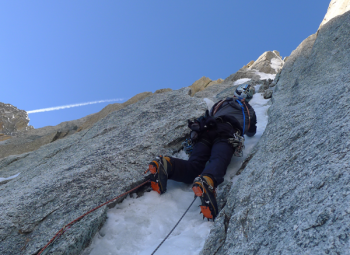60 second guide to ski mountaineering


There is something magical about standing on the summit of a mountain with skis on your feet. Especially after you’ve used ropes and ice axes to get there. But if you asked me the age-old question: when does ski touring become ski mountaineering? I’d still struggle for a definitive answer. It’s a bit like trying to define ‘extreme skiing’. For me, it’s when the climb up is as thrilling as the ski down. Here are some ski mountaineering definitions, starting with the left end of the spectrum…
Perhaps the best example of such a peak is the Pigne D’Arolla in Switzerland, situated halfway along the quintessential Haute Route from Chamonix to Zermatt. At just under 4000m high, this snowy dome often requires the use of ice axe and crampons, as well as route-finding skills through glaciated and crevassed terrain.
It’s a landing spot for Swiss heli-skiers – so don’t expect to be alone. But while the ski-tourers will limp over the col (the lowest point on the route to the Vignettes hut), and the heli-brigade will whoop down to their next rendezvous, the skier who stands on this splendid summit, gazing down the precipitous north face to the village of Arolla below, will feel every bit a mountaineer. The Alps is home to a veritable lifetime’s worth of great ski summits. Check out 260 Sommets des Alpes (by Reinhard Klappert, published by Franck) for more inspiration!
It is common to designate a snowy shoulder at the limit of skinning as a ‘winter summit’ (when it isn’t a summit at all). Far better is to view such a spot as a ski depot, and leave the planks and poles in favour of crampons and an ice axe – before skipping up to the real summit on foot.
A great example of such a peak is the Dreilanderspitze in the Silvretta Alps. A ski up to a fabulous ridge to stash the skis, then a rocky scramble, and a truly exhilarating alpine summit is all yours. This being Austria, you get a magnificent cross to mark the occasion, before scrambling back to your skis and enjoying the great ski down to the Jamtal hut. Magic!
Chamonix’s Vallée Blanche is a great place to see where skiers and mountaineers meet – and to understand the difference between the two. While the skiers are here for this epic and classic descent, the mountaineers view their skis as a tool that allows them to access the main event: the climbing!
There are some fantastic gullies and couloirs stuffed full of ice, perfect for the skiing mountaineer. Take the totally achievable Chere Couloir, for example. Descend the top of the Vallée Blanche and ski across the col to a point where skins will enable you to climb gently to the base of the Triangle du Tacul. From here, leave the skis and don the spikes and ropes, to climb half a dozen rope lengths of stunning ice in spectacular surroundings.
A few swift abseils and you’re back at your skis, the skiers have long since disappeared, and you have the rest of the descent of the Vallée Blanche to yourself.
Think about mountaineering and you invariably think of north faces – those cold, snowy places, best climbed when well-frozen in place. This begs the question: how are you going to get back down again? It is impossible to make progress in the alpine snowpack without snowshoes or skis – and why would any self-respecting skier choose snowshoes? So, slap your skis on the back of your pack, and climb the route.
They may be heavy, and a little unwieldy, but anyone who has spent a long time standing on the front points of their crampons will know how much easier it is in ski boots! Scrambling over the summit, it is time to pop the skis back on and cruise down to the valley. It’s about as much fun as you can have with your clothes on.
On the first ski ascent (and descent) of Kalanag in the Indian Garwhal Himalaya, I couldn’t believe how well suited skis were to expedition climbing. We had felt a little silly checking skis on to a flight to Delhi in May, but skinning from base camp to stock up the higher camps was a doddle with skis on. Dropping the kit and fuel for later on, we savoured a great ski back to base on perfect spring snow.
Finally the time came to make the summit bid. A full-on day of skiing and mountaineering got us to this lofty summit, before we enjoyed immaculate powder for a 1000m descent back to the tents. But don’t go with any naïve expectation of your return on investment: this 6385m peak took five days to climb, but only two and a half hours to get back down!